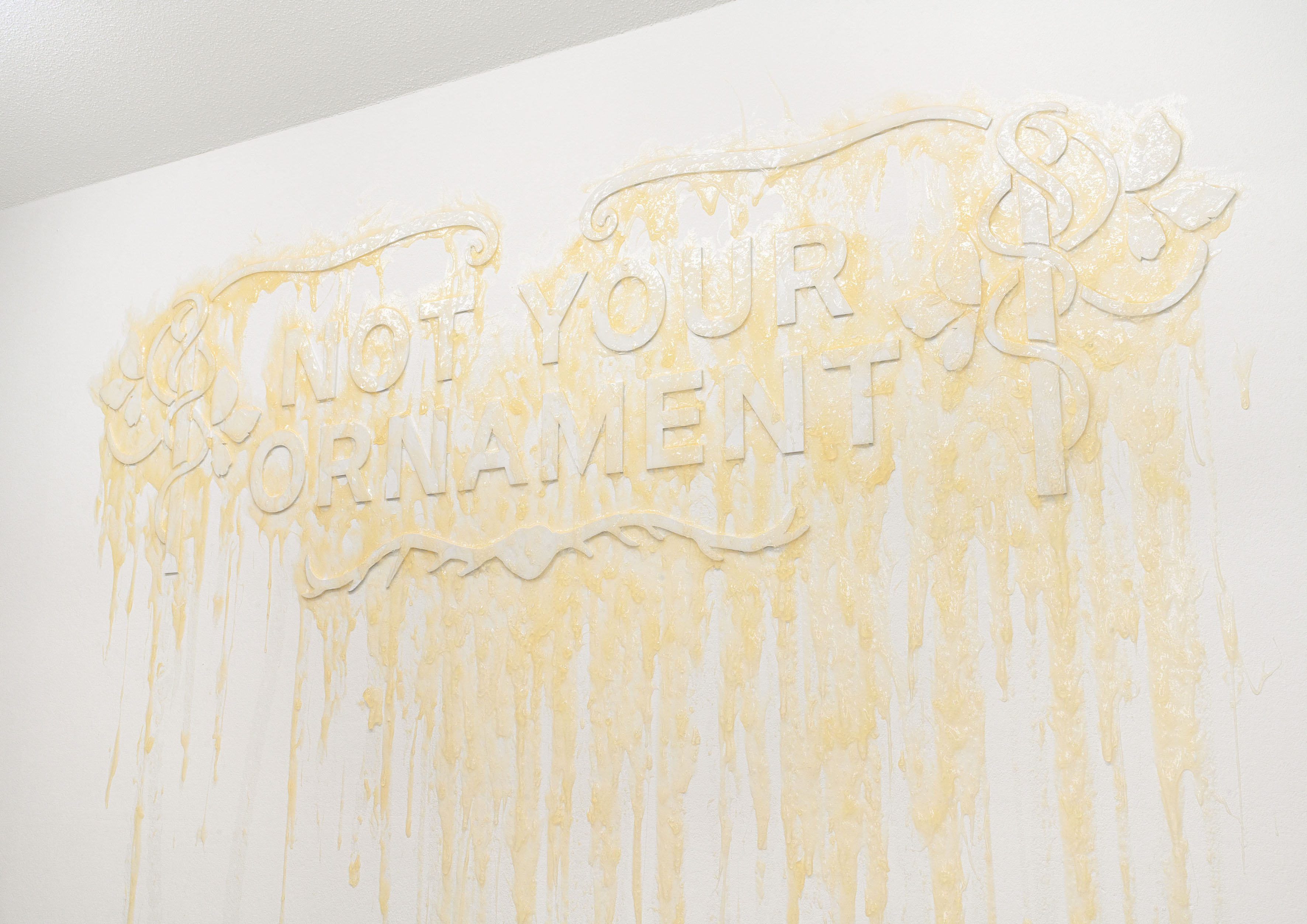YYYYMMDD >>> BACK HOME <<< >>> SELECTED FEATURES <<< >>> HIDDEN ARCHIVE <<<
[20230915]
NOT YOUR ORNAMENT by MAI LING at at SECESSION [from 20230915 to 20231112]
[Photos: Iris Ranzinger]
















Founded in Vienna in 2019, Mai Ling is an artists’ collective and association dedicated to facilitating dialogues on experiences of racism, sexism, homophobia, and any kind of prejudgment, particularly against Asian FLINT* (women, lesbian, inter, non-binary, and trans). Rooted in solidarity against patriarchal and racial discrimination, the group offers a space and growing network to give voice to the many individuals affected by such discrimination and foster new forms of collaboration. As an anonymous collective and a multi-hybrid figure, with everyone identifying as “Mai Ling,” the group employs a variety of artistic and discursive formats such as performances, texts, videos, sound, installations, talk series, interventions, and protests.
Mai Ling’s name refers to an eponymous television sketch from 1979 by the German comedian Gerhard Polt that showcases sexist and racial stereotypes and prejudices against Asian women in German-speaking society. Drawing from this work and addressing present-day issues, Mai Ling challenges the Western heteropatriarchal gaze and confronts racist fantasies that keep reproducing stereotypes about “Asia” and are still deeply embedded in and internalized by society.
In NOT YOUR ORNAMENT Mai Ling investigates the racialized and gendered logic of “Ornamentalism”—a term conflating “Orientalism” and “ornamental” that the American feminist scholar Anne Anlin Cheng discusses in her book of that title, which analyses how the European and American imagination has constructed Asian femininity as a hybrid human being and decorative object. Mai Ling challenges such an objectified condition through ornamental and invasive plants. Drawing on the Secession’s close relation to the Art Nouveau movement—often characterized by ornamental designs inspired by natural forms, such as flowers and plants—Mai Ling aims to reclaim their agency confronted by the decorative aesthetics that perpetuates the sexualization and dehumanization of Asian bodies within white society.
In this exhibition, the kudzu plant plays a central role in relation to the concept of “stickiness” as an agency of resistance and pleasure. Initially introduced as an “ornamental” plant during the Centennial International Exhibition of 1876 in the U.S., and later used in agriculture to prevent soil erosion, the vine is now considered invasive in most of the Western world. Native to East and Southeast Asia and some Pacific islands, kudzu is known for its beneficial properties as a weaving material and as part of traditional medicine and cuisine, with the starch of its roots being used as a thickener and sticky ingredient.
In their two-channel video installation Becoming Stickiness Mai Ling positions themselves and their own journey as one with kudzu—embracing its transformative, sticky, pleasurable, and resilient qualities. As the collective puts it: “Transforming and becoming with kudzu means developing our own abilities to take up space, merge with our surroundings, meander through obstacles, heal our kin, and spread freely. They say kudzu is difficult to eradicate because of its large, tuberous root structures. Let our own roots grow strong together.” The work begins with the search for kudzu, stickiness and pleasure through the gestures of experimenting, cooking, eating, sensing, interacting with, and embodying the invasive plant.
It culminates in a collective choreography in which multiple bodies intermingle and ultimately become one with plants, challenging the troubled tensions within the politicised dichotomies between human and object, between decorative and invasive.
In an environment of ornamental plants in soil, the visitors can listen to the many voices of Mai Ling. Unfolding both historical accounts and their individual memories in relation to commodified house plants brought to the Western world, each story exposes the intricate entanglement of ongoing horticultural colonialism, exoticism, and migratory experiences. At the same time, the wallpaper re-appropriates botanical designs for domestic spaces typically seen in the Art Nouveau movement. The group portrait at the end of the exhibition further connects to Mai Ling’s existence being intertwined with that of the ornamental and invasive plants.
Mai Ling emerged as a group from the need for a platform to share experiences collectively. Hence, stickiness as a form of pleasure and fostering a stronger community was at the heart of their activities even before the notion was introduced to their practice.
In order to amplify the many voices involved, their reading room allows not only insights into previous works but access to relevant discourses on collectivity as well as diasporic and migratory communities. By offering guided tours in multiple Asian languages during the exhibition, they create space for informal gatherings and exchange, inviting others to join them on a journey of Becoming Stickiness.
Programmed by the board of the Secession and curated by Christian Lübbert.
[Text: Christian Lübbert]
©YYYYMMDD All content and design by Daniela Grabosch + Ricardo Almeida Roque unless otherwise stated. Images, Videos and Texts can only be used under permission of the author(s).